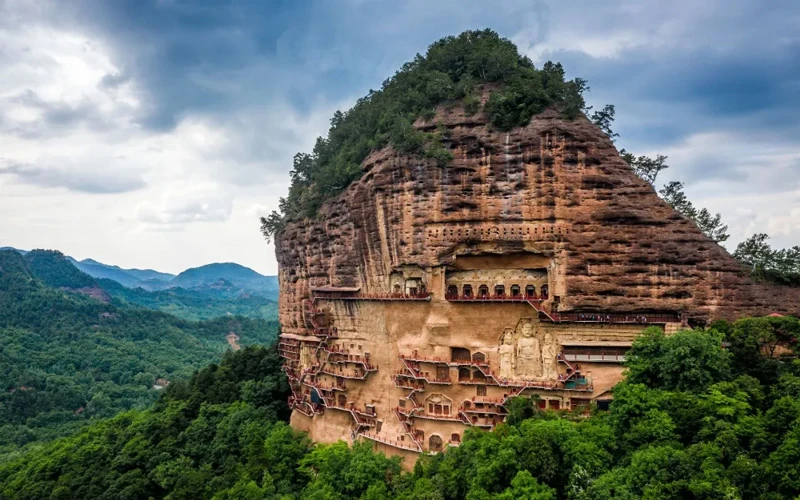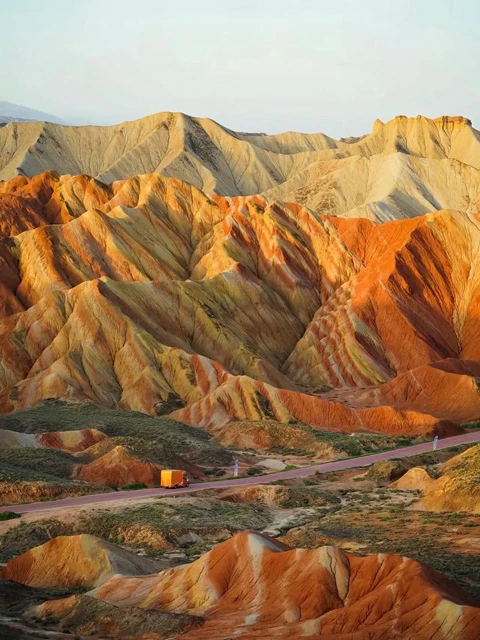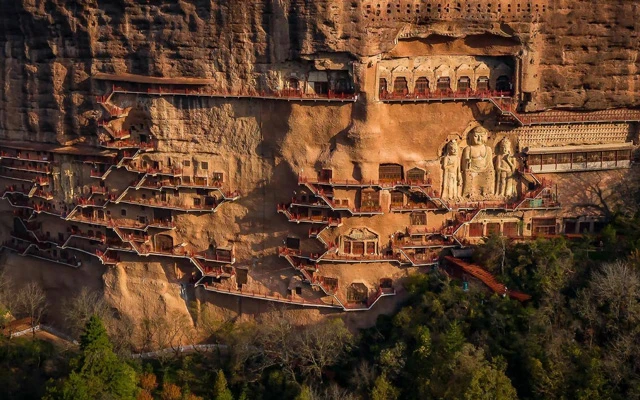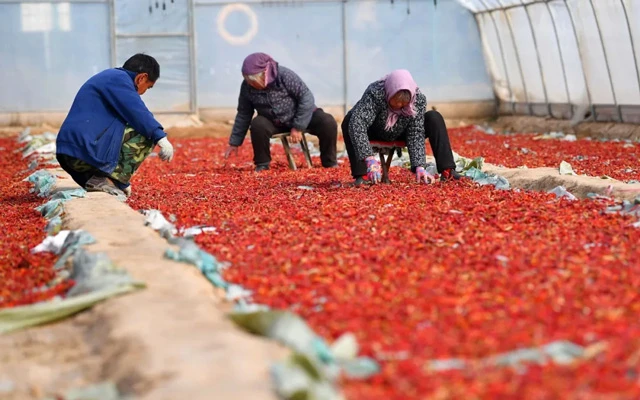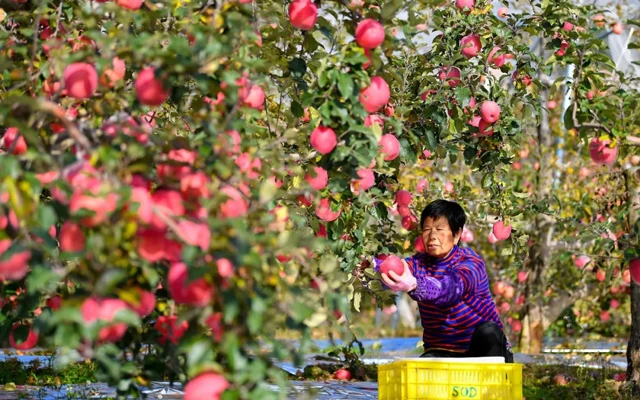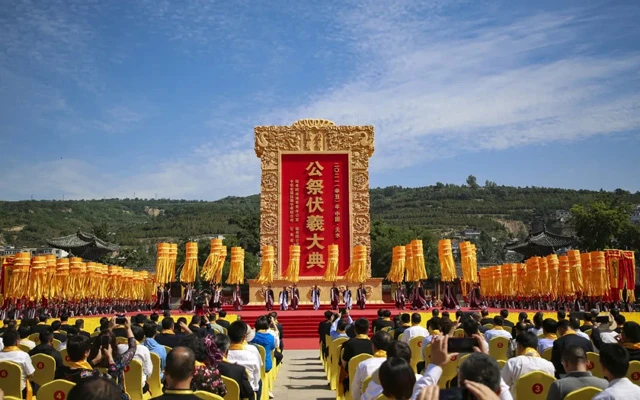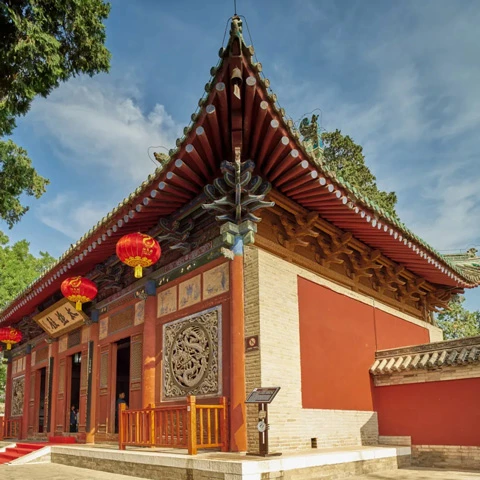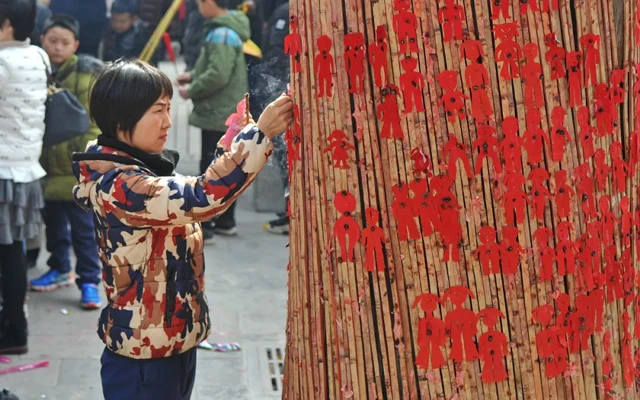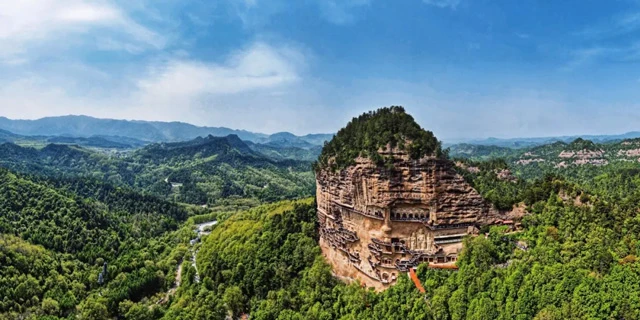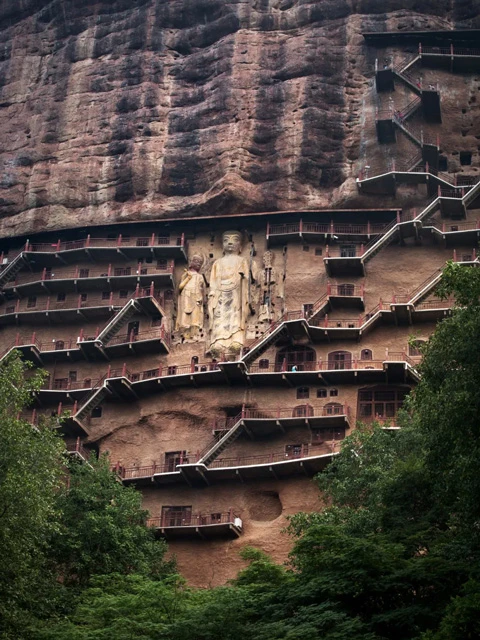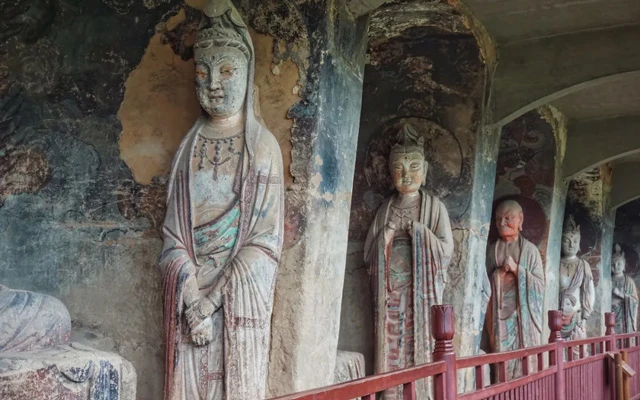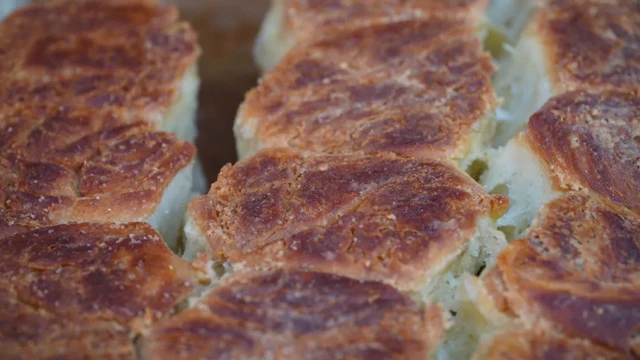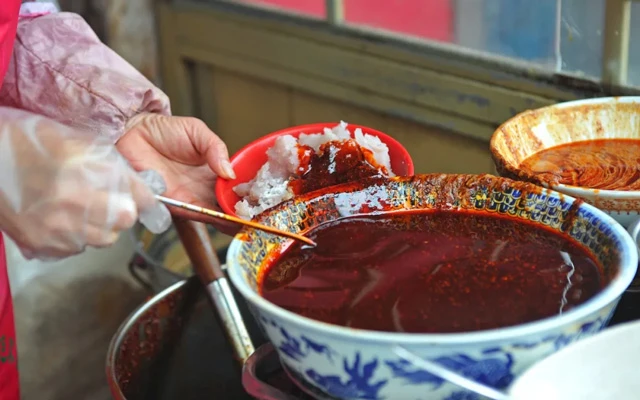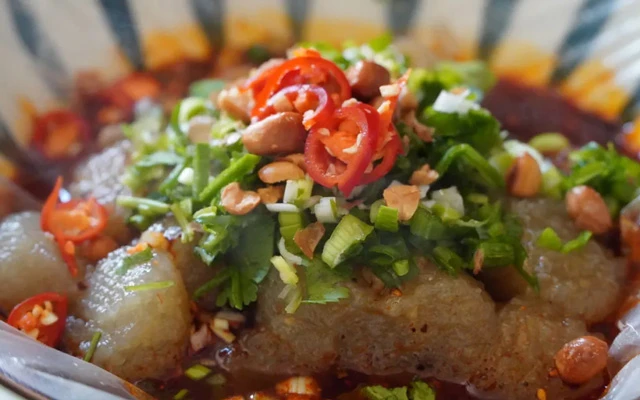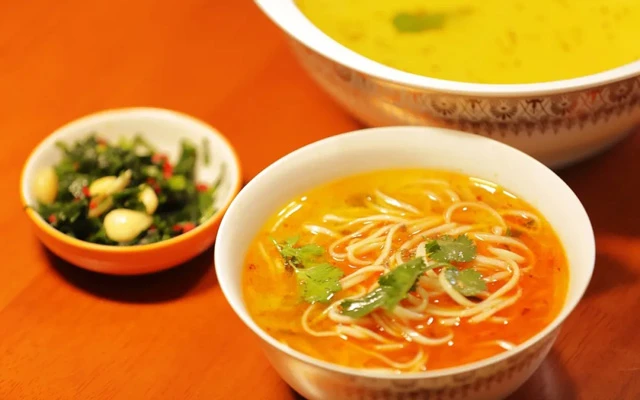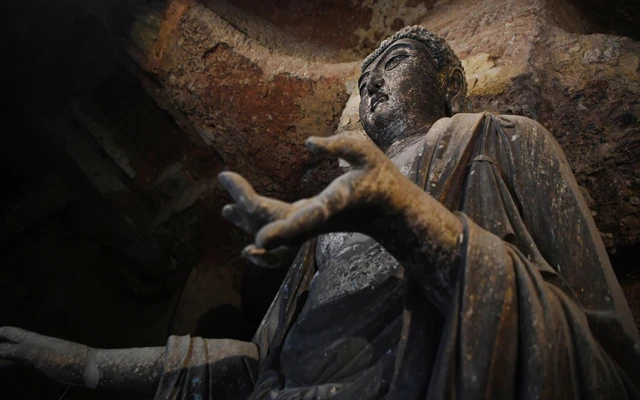The sensation of Malatang has taken Tianshui city by storm, leaving the locals perplexed. "No one in Tianshui would have ever imagined that Malatang would be the first to gain such popularity!" A friend from Tianshui subtly hinted at a touch of proud in their assessment of the local Malatang craze.
The reason for this lies in the abundance of treasures in this small northwestern city. Malatang restaurants have become "tourist attractions" with long queues, making the people of Tianshui feel somewhat aggrieved on behalf of the Fuxi Temple and the Maijishan Grottoes. Even in terms of souvenirs, aside from the rising popularity of Gangu chili peppers, there are also exquisite products such as Qinan peaches and Huaniu apples. Guided by the influx of visitors, waves of tourists are flocking to Tianshui. However, it can be asserted that "if you come to Tianshui and only eat Malatang, then you have missed out greatly!"
Amidst the tantalizing aroma of food and the mist of Maiji Mountain, the panoramic view in the Tianshui area gradually becomes clear. This city was the first stop on the Silk Road heading west from Chang'an, establishing itself as the premier city in northwestern China over a thousand years ago. In this article, let us explore the city of Tianshui together with Jiu Xing Travel.
Beyond chili peppers in Tianshui city
Even if you have not visited Tianshui, you must have recently seen scenes like this on social media—a shop owner serving up steaming hot dishes, repeatedly drizzling them with vibrant red chili oil, and kindly explaining to out-of-town diners: "Our chili oil may look spicy, but it tastes delightful."
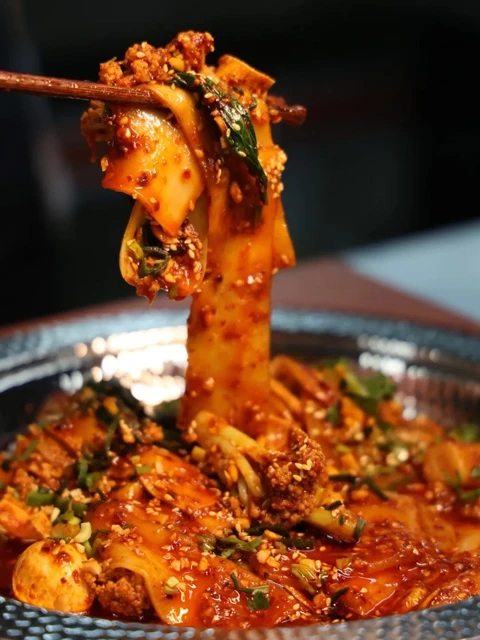
Malatang (麻辣烫)
Spoonful by spoonful, chili oil seems to nurture the soul of Tianshui's Malatang. Those who have tasted local Malatang in Tianshui are invariably disappointed when trying replicated versions elsewhere: how can the taste differ so greatly when the same method is used outside of Tianshui? What special magic do the peppers grown in Tianshui hold?
Tianshui's chili peppers are synonymous with Gangu. Gangu, hailed as the "Home of Chili Peppers," single-handedly carries the deep love of the entire nation for Tianshui's chili peppers. According to relevant data, in the past month alone, 13 chili pepper enterprises in Gangu County have sold approximately 640,000 catties of chili pepper products, with an average of around 20,000 catties of chili peppers leaving Tianshui every day.
The reputation of Gangu chili peppers has a long-standing history. Gangu County has records of cultivating chili peppers dating back to the Tianqi period of the Ming Dynasty, with a planting history of over 400 years. It is one of the earliest counties in China to cultivate chili peppers. The ability to grow peppers that are fragrant but not excessively spicy is due to the natural magic mixed with sunlight that falls on this land.
Unlike the common impression of the Northwestern region as vast desolate smoke, Gangu County has deep and fertile sloping soil, ample sunlight throughout the seasons, and a climate that is hot in summer and cool in winter without extreme cold or heat, making it extremely suitable for growing and sun-drying chili peppers. Therefore, the chili peppers grown in Gangu are generally characterized by their bright red color, thick flesh, rich oil content, and intense and fragrant taste. According to incomplete statistics, Gangu County's chili pepper products have an annual sales volume of up to 7,780 tons, with products selling well not only in many provinces and cities in China but also being exported to overseas regions such as Malaysia and South Korea.
However, the agricultural products that leave TianShui and sell oversea are much more than just chili peppers. Represented by the Huaniu apple, TianShui fruits have long made their debut both at home and abroad. The Huaniu apple can rival the American Red Delicious and the Japanese Fuji apple, being one of the "world's three famous apples," while TianShui is the hometown of the Huaniu apple.
TianShui, named after the "Tianhe irrigation," seems to have received special favor from nature. Located at the boundary between subtropical and warm temperate zones, TianShui has a mild climate and long sunshine hours. It is not only one of the best apple planting areas in the Loess Plateau region but has also nurtured fruits such as Qinan peaches, TianShui apricots, and TianShui cherries. In addition to its excellent climatic conditions, the Wei River running through the city and the Changjiang tributary "Xihan River" provide high-quality water sources for fruit and vegetable cultivation, collectively irrigating this fragrant gem of Tianshui.
The hometown of Fuxi, the top city on the Silk Road
From Lanzhou to TianShui, it is easy to create an illusion of accidentally entering the "Jiangnan" realm. Beneath the barrier of mountains, TianShui wanders among lush forests. The moist air and meandering rivers together paint a landscape distinct from the sunset over the yellow sand in the northwest. Deeper than hundreds of acres of forests is TianShui's cultural heritage. "Looking at Shanxi for five thousand years of history, looking at Gansu for eight thousand years of history." In TianShui, you can even experience the ancient legends of Fuxi and Nuwa up close.
When visiting TianShui, why not start your journey from the Fuxi Temple along the timeline. TianShui has two Fuxi Temples, one located on Guatai Mountain and the other built during the Ming Chenghua period, situated in the West Gate of TianShui. It is also the largest Fuxi sacrificial architectural complex in China today. Within the vast Fuxi Temple scenic area, everything is orderly arranged, with archways, main gates, main halls, and sleeping palaces lined up in sequence, courtyards overlapping. Stepping into the courtyard, you can see the dragon locust planted in the Tang Dynasty, standing tall after 1300 years of wind and sun, exuding ancient and distant charm.
In addition to the ancient locust trees from the Tang Dynasty, there are also ancient cypress trees planted according to the sixty-four hexagrams of Fuxi during the Ming Dynasty. Among the more than 20 surviving ancient trees, one is selected as the auspicious tree every year, regarded by the locals as the incarnation of Fuxi, worshipped, and called "welcoming the auspicious deity." During the Spring Festival, people will cut red paper into small figures and paste them on the ancient cypress in the temple, burning incense to symbolize the elimination of illness. The hand-cut red paper figures represent prayers for a good marriage.
When the hands of time reach the period of the Sixteen Kingdoms during the Jin Dynasty, the faint sound of Buddhist chants could be heard in the wind. As the first stop of the Silk Road heading west from Chang'an, and a crucial town connecting the borderlands, diverse religions and cultures converged here. Since the early Western Jin Dynasty, eminent monks from the Guanzhong region have come to this place to propagate and teach.
With the development of Buddhism in the Guanzhong region at that time, an increasing number of monks came here to meditate and teach, making the Maijishan area in Tianshui gradually become an important site for Zen practice in the Qinzhou region.
Maijishan, where monks gathered, is a solitary peak in the western section of the Qinling Mountains, standing aloof amidst the surrounding mountains and waters, earning the reputation of being the "crown of northwestern landscapes" and the "famous mountain of Longyou." Especially during misty and foggy weather, it resembles a fairyland palace in the clouds. Another marvel of Maijishan is the Maijishan Grottoes. Beginning with the eastern and western cliffs, these grottoes were first constructed during the Later Qin period of the Sixteen Kingdoms, spanning over a thousand years through the Northern Wei Dynasty to the Ming and Qing Dynasties.
"Among the steep cliffs, stone carvings of Buddhas adorn the walls, with thousands of niches and chambers. Though crafted by human hands, one might suspect a touch of the supernatural." Even today, visitors who gaze up at the Maijishan Grottoes from below the cliffs cannot help but exclaim in awe, echoing the sentiments of ancient observers. From the eastern cliff to the western cliff, the "Twelve-story Qiong Tower" on the cliff face connects the grottoes carved by craftsmen from different dynasties, along with meticulously sculpted Buddha statues, creating an illusion of a tunnel through time and space.
The remaining 221 caves, weathered by time, preserve the essence of Buddhist sculpture art from various eras. Among them, the "Bao Rou Su" displayed in Cave 4 is a unique sculptural form of the Maijishan Grottoes. This technique, combining painting and sculpting, gives the celestial figures a lively and elegant appearance, while maintaining a sense of three-dimensional fullness. In addition, there are several caves of great significance, such as the iconic Cave 44 of the Western Wei Dynasty featuring a Buddha and two Bodhisattvas with enigmatic smiles, and the Northern Wei Dynasty stele with over 4000 Buddhas carved on 18 stones in Cave 133, known as the "Cave of Ten Thousand Buddhas."
From the Fuxi Temple in the west to the prehistoric site of Dadiwan, the Qin tombs at Fangmatan, the Maijishan Grottoes, and the Ming Dynasty residential buildings of the Hu family known as "North and South Houses," the evolution of human history and culture has left a profound mark on the land of Tianshui. Under the gentle gaze of the Buddha statues, as time flows on, the bustling city still thrives.
The spiritual homeland of cuisine lovers
Many food enthusiasts travel far and wide to the northwest for an authentic bowl of spicy Malatang in Tianshui. However, in Tianshui, to only indulge in Malatang would be a tremendous loss. "For locals, Malatang is not even considered a notable delicacy!" The hearts of Tianshui's friends itch to recommend culinary delights. For this city composed of carbs, the mastery of simple ingredients has reached its peak.
Following the people of Tianshui for a day, one truly understands what it means to have a carb-filled day from morning till night. Pork lard box, yellow steamed bun, "gua gua," and a bowl of bone soup or almond tea can be paired in twos or come together to form the most solid breakfast combination.
Though the Tianshui pork lard box frequents the streets and alleys, it is a genuine food of the "royal family," originating from the Qing Dynasty court's "pork lard bun." The simple combination of flour, pork lard, sesame oil, and salt, cooked half-baked and half-fried, conceals an incredibly crispy and fragrant texture beneath its unassuming appearance.
Dishes like "gua gua," "ran ran," "lao lao," and others, although bearing cute names typical of Tianshui cuisine, reveal their hardcore essence only when tasted. Buckwheat and potatoes uphold half of Tianshui's culinary territory, providing a spiritual home for carb enthusiasts. The "gua gua," made from buckwheat starch, is the foremost delicacy of Qinzhou.
It appears crystal clear and tender, yet when eaten, it possesses a meaty texture and gelatinous feel—a large bowl of buckwheat slurry cooled and solidified, crushed into small pieces, mixed with seasonings, and topped with a generous spoonful of chili oil yields a successful dish. While "gua gua" claims the top spot, the "ran ran," made from potato starch, naturally does not lag behind. Although they may look similar, compared to the firm texture of "gua gua," "ran ran" offers a more glutinous fragrance.
Moving away from the breakfast table, potatoes transform into ubiquitous potato balls. How many ways are there to enjoy potato balls? Even the locals get confused when counting on their fingers. According to local descriptions, the most classic way to enjoy potato balls is to fry them first and then cook them, wrap them in spicy condiments and stuff them into pancakes, savoring the blissful joy of carb-filled delights to the fullest.
Even in the nationally popular spicy Malatang, the presence of potato balls cannot be overlooked. If one were to inquire why fried balls are cooked again, the answer lies in "very few people enjoy eating hard balls; just like the character of the people of Tianshui, they can be tough, but most of the time, they are tender and yielding."
Apart from buckwheat and potatoes, the other half of Tianshui's culinary glory rests on the shoulders of wheat. As a gathering place for enthusiasts of staple foods, Tianshui's wheat boasts 100 ways of making an appearance, including but not limited to hand-pulled noodles, beef tendon noodles, hand-pulled noodles with stuffed pancake, noodle fish, and a series of classic programs.
Although the hand-pulled noodles dressed in chili oil is the most widely accepted street food, the distinctive and delectable noodle soup must not be overlooked. "Jiangshui" originates from each family's own fermentation jar, where shepherd's purse or celery ferments with noodle soup at high temperatures. The slightly sour taste not only refreshes and relieves greasiness but also serves as the ultimate cooling remedy for summer heat.
From the grottoes to the streets, having a bowl of noodle soup on the roadside, in this mild climate of the small northwest city, one is surrounded by the fiery and vibrant atmosphere. Once a small city on the Silk Road connecting the north and south, bridging the gap between the interior and exterior, this city is now stretching its arms wide, embracing all those who come to visit once again.
